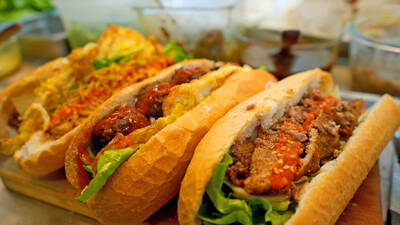As retail stocks plunged on Monday, Paris designers came up with antidotes to the economic blues plaguing the luxury industry.
British designer John Galliano tapped tribal influences in his ready-to-wear show for Christian Dior. Yohji Yamamoto created a haven for Zen contemplation, while Vivienne Westwood had simple advice for fashion addicts hit by the downturn: do it yourself!
French fashion label Cacharel celebrated its 50th anniversary as the Dow Jones shuddered. The index lost nearly 800 points, the biggest point drop ever for a single day, after the US House of Representatives unexpectedly defeated a US$700 billion emergency plan for the country’s financial system.
CHRISTIAN DIOR
Galliano went tribal for his Dior collection — tribal chic, that is.
The rebel designer used studs, staples, shells and python leather to toughen up thigh-grazing summer dresses and translucent evening gowns in his spring-summer collection, shown in a tent in the Tuileries gardens in front of guests including actresses Emma Watson, Marion Cotillard and Eva Green.
Models with hair crimped and teased into conical bobs strutted down the catwalk in fierce platform sandals, some featuring intricately carved heels that resembled fertility statues.
It was a far cry from the demurely elegant outfits that have made Dior the label of choice of France’s first lady, Carla Bruni-Sarkozy, but the see-through skirts will likely be lined once they hit the shop floor, if only to cater to Dior’s large Middle Eastern clientele.
That will leave Bruni-Sarkozy free to pick from red carpet stunners including a striped black silk dress with a jet bead embroidered bodice.
YOHJI YAMAMOTO
Yamamoto found a perfect recipe for meditation: ghostly models ambling along an illuminated catwalk, a monochrome color scheme and a soothing live piano sound track.
The Japanese master of minimalism appeared to have distilled fashion to its purest essence, all the while indulging his penchant for surrealist exercises like attaching strips of fabric to the elbow of a perfectly tailored black jacket, or blowing up a white shirt to oversized proportions.
In the latest of a series of collaborations with other brands, he unveiled a line of 1950s-style cat eye sunglasses developed with Linda Farrow Vintage.
Yamamoto, who turns 65 this week, is also about to fulfill a lifelong dream with the imminent opening of a Paris flagship store on the exclusive Rue Cambon — a few doors down from the former apartment of his style mentor, Gabrielle “Coco” Chanel.
CACHAREL
Cacharel, which helped to revolutionize women’s fashion in the 1960s with its flirty, feminine creations, celebrated its 50th anniversary with a catwalk show that looked both to the past and the future.
The first half of the display showcased the creations of Mark Eley and Wakako Kishimoto, the design duo better known as Eley Kishimoto, who were hired last year to give the brand a face-lift.
Models paraded in easy, breezy summer dresses and pajama-style slacks in upbeat shades of mustard, turquoise and purple, some featuring printed or crocheted motifs of migrating birds for a retro tinge.
Then, in a surprise finale, dozens of models emerged in the label’s vintage Liberty floral print cotton dresses, before taking a bow with 76-year-old founder Jean Bousquet.
VIVIENNE WESTWOOD
Westwood earned the nickname of Queen of Punk by cobbling together outfits for the Sex Pistols with safety pins. Now she wants you to do the same.
“In these hard times — dress up,’’ she said in a handwritten statement handed out to guests. “There is status in wearing your favorites over and over until they grow old (patina) or fall apart.’’
One model stepped down the catwalk wrapped in reams of lush pink taffeta straight off the roll and gladiator sandals with natural leather straps that extended all the way up the thigh.
Ever the political campaigner, the flame-haired British designer took her bow wearing a green T-shirt emblazoned with “US$30 billion’’ — the sum she said was needed per year to save the rainforest.
It was not the first time Westwood has criticized the futility of the fashion industry, but it was hard not to feel like she was shooting herself in the foot. After all, if anyone can do it, why pay big bucks for designer duds?

Following the rollercoaster ride of 2025, next year is already shaping up to be dramatic. The ongoing constitutional crises and the nine-in-one local elections are already dominating the landscape. The constitutional crises are the ones to lose sleep over. Though much business is still being conducted, crucial items such as next year’s budget, civil servant pensions and the proposed eight-year NT$1.25 trillion (approx US$40 billion) special defense budget are still being contested. There are, however, two glimmers of hope. One is that the legally contested move by five of the eight grand justices on the Constitutional Court’s ad hoc move

Stepping off the busy through-road at Yongan Market Station, lights flashing, horns honking, I turn down a small side street and into the warm embrace of my favorite hole-in-the-wall gem, the Hoi An Banh Mi shop (越南會安麵包), red flags and yellow lanterns waving outside. “Little sister, we were wondering where you’ve been, we haven’t seen you in ages!” the owners call out with a smile. It’s been seven days. The restaurant is run by Huang Jin-chuan (黃錦泉), who is married to a local, and her little sister Eva, who helps out on weekends, having also moved to New Taipei

The Directorate-General of Budget, Accounting and Statistics (DGBAS) told legislators last week that because the Chinese Nationalist Party (KMT) and Taiwan People’s Party (TPP) are continuing to block next year’s budget from passing, the nation could lose 1.5 percent of its GDP growth next year. According to the DGBAS report, officials presented to the legislature, the 2026 budget proposal includes NT$299.2 billion in funding for new projects and funding increases for various government functions. This funding only becomes available when the legislature approves it. The DGBAS estimates that every NT$10 billion in government money not spent shaves 0.05 percent off

Dec. 29 to Jan. 4 Like the Taoist Baode Temple (保德宮) featured in last week’s column, there’s little at first glance to suggest that Taipei’s Independence Presbyterian Church in Xinbeitou (自立長老會新北投教會) has Indigenous roots. One hint is a small sign on the facade reading “Ketagalan Presbyterian Mission Association” — Ketagalan being an collective term for the Pingpu (plains Indigenous) groups who once inhabited much of northern Taiwan. Inside, a display on the back wall introduces the congregation’s founder Pan Shui-tu (潘水土), a member of the Pingpu settlement of Kipatauw, and provides information about the Ketagalan and their early involvement with Christianity. Most